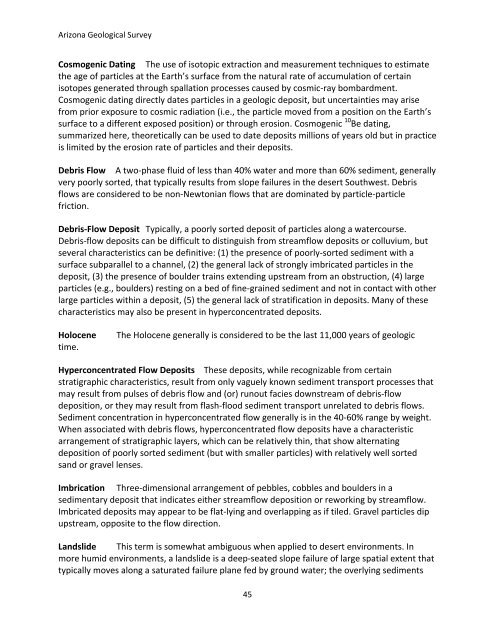Arizona Geological Survey OPEN-FILE REPORT OFR 08-06
Arizona Geological Survey OPEN-FILE REPORT OFR 08-06
Arizona Geological Survey OPEN-FILE REPORT OFR 08-06
Create successful ePaper yourself
Turn your PDF publications into a flip-book with our unique Google optimized e-Paper software.
<strong>Arizona</strong> <strong>Geological</strong> <strong>Survey</strong><br />
Cosmogenic Dating The use of isotopic extraction and measurement techniques to estimate<br />
the age of particles at the Earth’s surface from the natural rate of accumulation of certain<br />
isotopes generated through spallation processes caused by cosmic‐ray bombardment.<br />
Cosmogenic dating directly dates particles in a geologic deposit, but uncertainties may arise<br />
from prior exposure to cosmic radiation (i.e., the particle moved from a position on the Earth’s<br />
surface to a different exposed position) or through erosion. Cosmogenic 10 Be dating,<br />
summarized here, theoretically can be used to date deposits millions of years old but in practice<br />
is limited by the erosion rate of particles and their deposits.<br />
Debris Flow A two‐phase fluid of less than 40% water and more than 60% sediment, generally<br />
very poorly sorted, that typically results from slope failures in the desert Southwest. Debris<br />
flows are considered to be non‐Newtonian flows that are dominated by particle‐particle<br />
friction.<br />
Debris‐Flow Deposit Typically, a poorly sorted deposit of particles along a watercourse.<br />
Debris‐flow deposits can be difficult to distinguish from streamflow deposits or colluvium, but<br />
several characteristics can be definitive: (1) the presence of poorly‐sorted sediment with a<br />
surface subparallel to a channel, (2) the general lack of strongly imbricated particles in the<br />
deposit, (3) the presence of boulder trains extending upstream from an obstruction, (4) large<br />
particles (e.g., boulders) resting on a bed of fine‐grained sediment and not in contact with other<br />
large particles within a deposit, (5) the general lack of stratification in deposits. Many of these<br />
characteristics may also be present in hyperconcentrated deposits.<br />
Holocene<br />
time.<br />
The Holocene generally is considered to be the last 11,000 years of geologic<br />
Hyperconcentrated Flow Deposits These deposits, while recognizable from certain<br />
stratigraphic characteristics, result from only vaguely known sediment transport processes that<br />
may result from pulses of debris flow and (or) runout facies downstream of debris‐flow<br />
deposition, or they may result from flash‐flood sediment transport unrelated to debris flows.<br />
Sediment concentration in hyperconcentrated flow generally is in the 40‐60% range by weight.<br />
When associated with debris flows, hyperconcentrated flow deposits have a characteristic<br />
arrangement of stratigraphic layers, which can be relatively thin, that show alternating<br />
deposition of poorly sorted sediment (but with smaller particles) with relatively well sorted<br />
sand or gravel lenses.<br />
Imbrication Three‐dimensional arrangement of pebbles, cobbles and boulders in a<br />
sedimentary deposit that indicates either streamflow deposition or reworking by streamflow.<br />
Imbricated deposits may appear to be flat‐lying and overlapping as if tiled. Gravel particles dip<br />
upstream, opposite to the flow direction.<br />
Landslide This term is somewhat ambiguous when applied to desert environments. In<br />
more humid environments, a landslide is a deep‐seated slope failure of large spatial extent that<br />
typically moves along a saturated failure plane fed by ground water; the overlying sediments<br />
45
















